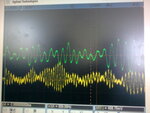Jr9910
Newbie level 3
I captured the signals from the sensor, which is the sine waveform with a random bias of low frequency. I want to use the CD4046 consisting a narrow bandwidth filter tracking this signal and filter out the random bias. Is it possible ? Otherwise, if I use the Comparator II, its center frequency depends on the R1 and C1, is there any formula to calculate the f0 using R1 and C1 exactly ? I also want to know if I can design the filter bandwidth to 2~10Hz to filter the random noise, Because the capture range and the lock range doesn't relay on the parameter of the LPF using Comparator II. The signal with green color is the conditioning circuit output, which has a better performance. The yellow one is past a pull performance circuit.

